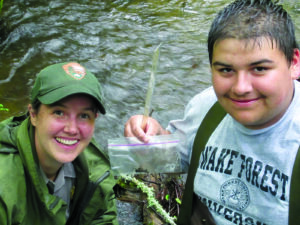Cherokee High School Forestry students have been actively participating with a citizen science project which encourages students and visitors in national parks to collect dragonfly larvae for mercury analyses. The study connects people to parks and provides baseline data to better understand the spatial distribution of mercury contamination in national parks.

CHS student Jake Crowe (right) holds up dragonfly larvae he collected as part of a recent study in the Great Smoky Mountain National Park. He is shown with Great Smokies ranger Emily Darling. (Photo courtesy of Cherokee Central Schools)
Dragonfly larvae (Odonata anisoptera) can serve as indicators of ecosystem health by characterizing the risk and potential toxic effects of mercury. These aquatic macroinvertebrates are long-lived (up to 5 years as larvae) before emerging as adult dragonflies, widespread across the U.S., predatory (i.e., prone to higher concentrations of mercury), important prey for fish species, and they reflect the mercury sensitivity of a specific watershed. Moreover, they are relatively easy to collect! This citizen science project expands the geographic scope of research previously conducted by scientists, provides data that can be compared across parks, and helps raise awareness about mercury impacts.
On a chilly (20F) Friday, November 18, 2011, six CHS students helped with the first dragonfly larvae collection in the Great Smoky Mountains National Park at the mid-elevation Chasteen Creek site – over a mile upstream from Smokemont Campground. Several specimens were found and collected. On a much warmer, rainy May 9, 2012 morning, four more CHS students collected dragonfly larvae. Several larger specimens were collected, identified, and prepared for testing.
Ami Riscassi, a Postdoctoral Research Associate from the Oak Ridge Institute for Science and Education in Oak Ridge National Lab, Oak Ridge, TN, Colleen Flanagan of the Air Resources Division from Denver, CO, GSMNP Ranger Emily Darling, one park staff, and CHS Forestry teacher Emory Rhoads assisted with the collections.
Four national parks, including the Great Smoky Mountains National Park, collected samples in previous years and are committed to participate during the 2012 season. A grant to University of Maine for 2012 supports program expansion to include an additional six to eight parks throughout the Mid-Atlantic, Cumberland-Piedmont, Southeast, Great Lakes, Western U.S., and Alaska areas.
– Cherokee Central Schools




